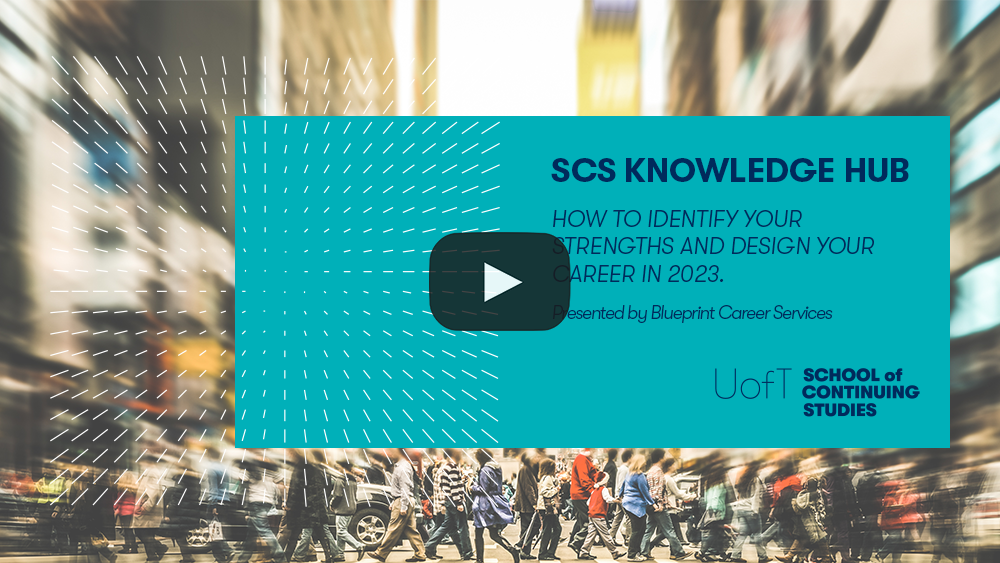
“It’s not just about recognizing your strengths. It’s about seeing that this is just the beginning. Real change takes place when you nurture and cultivate those strengths. Don’t passively wait for things to happen to you. Go out and engage in activities which elevate your strengths.” – Ann Park, Career Strategist
SCS recently launched a new season of free Knowledge Hub webinars. Presented in partnership with the school’s new Blueprint Career Services, the first webinar delved into some of the keys to identifying your strengths and designing the career you want in 2023.
Panelists Career Development Officer Yoyo Eto and Career Strategist Ann Park introduced some of the basic concepts behind Blueprint’s new in-depth, interactive workshops: CliftonStrengths and Designing Your Life’s Work.
Park kicked things off by pointing out that Canadians are currently experiencing an “employees’ market” with plenty of opportunities for people who are hoping to change or pivot in their careers.
She went on to illustrate the natural tendency people can have to focus on their weaknesses, rather than their strengths, by asking webinar participants to compare what it felt like to write their names with their dominant and non-dominant hands. By changing this mindset and focusing on our strengths, we can achieve greater results and personal satisfaction, she explained. She noted that this is where concepts developed and inspired by Donald Clifton can help.
“Donald Clifton was the father of positive psychology,” she said. “And he posed the question: What would happen if we studied what was right with people instead of what was wrong with people? In the 1950s he conducted a series of interviews with highly successful people to find out what made them successful. Were they born into certain circumstance or privilege? Was it just luck? What was going on? What quickly became evident was that these people used their greatest strengths and talents, things that were natural, to achieve excellence.”
Beyond reflecting on and identifying your innate strengths, something Park said the SCS CliftonStrengths workshops can help learners to do, it is also vital to take actions that will allow you to harness and express those strengths effectively.
Park said first it is important to focus on what you enjoy most and do best.
“Don’t waste your time trying to do things because other people say ‘Oh you should do this. If you do this you’ll make more money or there’s more prestige.’ No. Focus on what you do best and what you enjoy.”
Next, Park said, you must take an active role in individual development.
“So this means it’s not just about recognizing your strengths. It’s about seeing that this is just the beginning,” she explained. “Real change takes place when you nurture and cultivate those strengths. Don’t passively wait for things to happen to you. Go out and engage in activities which elevate your strengths.”
Thirdly, Park said it is important for those who are currently working, to engage in active dialogue with your managers about your career and skills development. if you’re currently working, engage in dialogue with your manager about it.
“Ongoing dialogue such as quick check-ins create a perfect setting to set expectations, review successes and recalibrate processes. And ask for feedback! That’s how we learn and we grow,” she concluded.
Eto joined the conversation to share how, in addition to Park’s tips, people can use the principles of design thinking to advance their careers.
“Design thinking is commonly used when we are working maybe in the tech industry, designing a product or a program…It involves problem-finding so you can understand what the problem you’re trying to solve is, and then prototyping your way into better and better solutions in little steps. So in essence design thinking, or building your way forward, is a way of thinking and approaching problems.”
In design thinking, once you have defined a problem’s scope and its shape, it is time to move on to ideation, the phase of the process where participants are encouraged to brainstorm any and all ideas to solve the problem.
No idea is too impractical, explained Eto. “Designers use this technique to get past our brains’ tendencies to block good ideas. In life design it’s the same thing. Coming up with as many ideas as we can to solve our problem and then we can choose.”
Once you’ve selected one or two of your best ideas, it’s time to pick a prototype, said Eto. “In product design this looks like a sample. But in life design prototypes are designed to ask questions, test things out, get a feel for what things are,” she added. “So they require questioning, talking to people, gathering data to figure out will I like this career? Will I like this role? Will I like retirement?”
Eto also highlighted that acceptance of where you are now, and reframing problems are important aspects of life design. “So for example, when the pandemic first started a belief a lot of people had was ‘I spent the last few years preparing for my dream career but COVID-19 sent me on a new path and now I have no idea what to do and I’m absolutely stuck,’” she said.
“A reframe of that would be ‘Yes COVID-19 has required me to pivot from my original career goal, but what does this provide me? Opportunity to reflect, reorient, better understand my values, and come up with what my life purpose is.’ So it really does look at what does a pivot look like, where do I go next, now that there has been a change or I want a change.”
See the full webinar recording, including a follow-up question and answer session, below.

